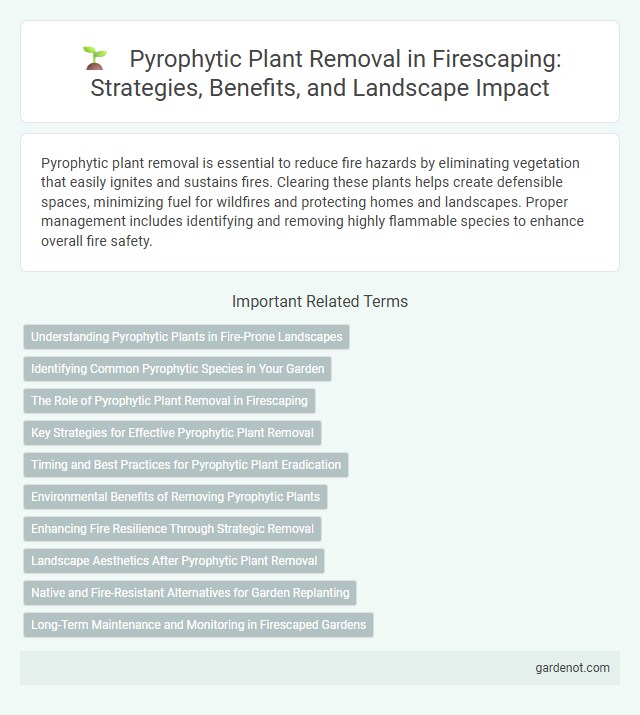Pyrophytic plant removal is essential to reduce fire hazards by eliminating vegetation that easily ignites and sustains fires. Clearing these plants helps create defensible spaces, minimizing fuel for wildfires and protecting homes and landscapes. Proper management includes identifying and removing highly flammable species to enhance overall fire safety.
Understanding Pyrophytic Plants in Fire-Prone Landscapes
Pyrophytic plants possess specialized adaptations that enable them to survive and even thrive in fire-prone landscapes, such as thick bark, deep root systems, and fire-resistant seeds. Understanding the ecological role of these plants is essential for effective firescaping, as their removal can reduce fuel loads and minimize wildfire risks. Proper management strategies balance preserving native pyrophytic species while mitigating fire hazards to protect property and ecosystems.
Identifying Common Pyrophytic Species in Your Garden
Identifying common pyrophytic plant species such as chaparral, manzanita, and scrub oak is crucial for effective firescaping and pyrophytic plant removal. These plants contain oils and resins that ignite easily, increasing wildfire risk in residential areas. Removing or managing these species reduces fuel load and enhances fire-resistant landscaping strategies.
The Role of Pyrophytic Plant Removal in Firescaping
Pyrophytic plant removal plays a crucial role in firescaping by reducing the availability of highly flammable vegetation that can accelerate wildfire spread. Removing or managing pyrophytic species such as chaparral, sagebrush, and certain pines helps create defensible spaces around properties, decreasing fuel load and fire intensity. Strategic elimination of these plants supports landscape resilience and enhances firefighter safety during wildfire events.
Key Strategies for Effective Pyrophytic Plant Removal
Effective pyrophytic plant removal involves identifying highly flammable species such as chaparral, manzanita, and juniper to reduce wildfire fuel loads. Employing mechanical removal tools like brush cutters and chainsaws, combined with targeted herbicide applications, ensures thorough eradication of fire-prone vegetation. Regular monitoring and maintenance prevent regrowth, enhancing landscape resilience and supporting fire-safe environments.
Timing and Best Practices for Pyrophytic Plant Eradication
Pyrophytic plant removal is most effective during the dormant season, typically late fall to early spring, when these fire-adapted species are less resilient and easier to eradicate. Employing mechanical methods such as cutting or uprooting combined with targeted herbicide application ensures thorough eradication and reduces the risk of regrowth. Consistent monitoring post-removal is critical to promptly address any resprouting and maintain a fire-safe landscape.
Environmental Benefits of Removing Pyrophytic Plants
Removing pyrophytic plants reduces wildfire risks by eliminating highly flammable vegetation that can rapidly spread fire. This enhances ecosystem resilience and protects native biodiversity by preventing destructive fires. Fire-adapted invasive species removal promotes soil stability and water quality, supporting overall environmental health.
Enhancing Fire Resilience Through Strategic Removal
Strategic removal of pyrophytic plants significantly enhances fire resilience by reducing the availability of highly flammable vegetation that fuels wildfires. Targeting species such as chaparral, eucalyptus, and certain pine varieties minimizes fire intensity and spread, thereby protecting property and ecosystems. Implementing a tailored pyrophytic removal plan integrated with fire-safe landscaping practices strengthens overall community defense against wildfire damage.
Landscape Aesthetics After Pyrophytic Plant Removal
Removing pyrophytic plants can significantly enhance landscape aesthetics by promoting the growth of fire-resistant, visually appealing vegetation. This process reduces the risk of wildfires while encouraging the establishment of native, drought-tolerant species that provide vibrant colors and textural diversity. Proper removal and replacement improve overall landscape health and create safer, more attractive outdoor spaces.
Native and Fire-Resistant Alternatives for Garden Replanting
Pyrophytic plant removal is essential for reducing wildfire risk by eliminating highly flammable vegetation. Replanting with native and fire-resistant alternatives such as manzanita, ceanothus, and California lilac helps create defensible spaces while supporting local ecosystems. These plants offer low combustibility, drought tolerance, and soil stabilization, making them ideal for sustainable firescaping strategies.
Long-Term Maintenance and Monitoring in Firescaped Gardens
Long-term maintenance and monitoring of pyrophytic plant removal in firescaped gardens ensure sustained fire resistance by preventing the reestablishment of highly flammable species. Regular inspections target unwanted regrowth of invasive, drought-adapted shrubs such as chaparral or manzanita, which can reignite fire hazards. Employing adaptive management strategies and timely removal supports ecological balance while maintaining defensible space around structures.
Pyrophytic plant removal Infographic

 gardenot.com
gardenot.com